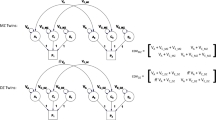Abstract
BEFORE recent developments with marker genes, it was not possible to assign with certainty the zygosity of a substantial proportion of twin pairs. So it was usual, when estimating the incidence of monozygotic (MZ) and dizygotic (DZ) pairs, to use Weinberg's differential rule1, which postulates that among DZ pairs the frequencies of same sex and of opposite sex pairs are almost exactly equal (the difference from equality being occasioned by an adjustment for the sex ratio). Although it is important to know whether this is true, as far as I know, it has never been adequately tested, though the suggestion has been made more than once that estimates (based on Weinberg's rule) of the frequency of MZ twins seem to be too high10,15. I have some suggestions to explain this disparity.
Similar content being viewed by others
References
Weinberg, W., Arch. Ges. Physiol., 88, 346 (1902).
Simmons, R. T., Graydon, J. J., Jacobowicz, R., and Doig, R. K., Med. J. Austral., ii, 246 (1960).
Cameron, A. H., Proc. Roy. Soc. Med., 61, 229 (1968).
Nylander, P. P. S., J. Obstet. Gynaec. Brit. Commonwealth, 77, 506 (1970).
Smith, S. M., and Penrose, L. S., Ann. Human Genet., 19, 273 (1955).
Potter, E. L., Amer. J. Obstet. Gynec., 87, 566 (1963).
Walsh, R. J., and Kooptzoff, O., Austral. J. Exp. Biol. Med. Sci., 33, 189 (1955).
Corney, G., Robson, E. B., and Strong, S. J., Ann. Human Genet., 32, 89 (1968).
Nylander, P. P. S., J. Obstet. Gynaec. Brit. Commonwealth, 76, 699 (1969).
Nylander, P. P. S., and Corney, G., Ann. Human. Genet., 33, 31 (1969).
Stevenson, A. C., Ann. Human Genet., 23, 415 (1959).
Tricomi, V., Serr, D., and Solish, G., Amer. J. Obstet. Gynec., 79, 505 (1960).
Carr, D. H., Obstet. Gynec., 26, 308 (1965).
Barr, A., and Stevenson, C., Ann. Human Genet., 25, 131 (1961).
Renkonen, K. O., Ann. Human Genet., 30, 277 (1967).
Cannings, C., Ann. Human Genet., 32, 403 (1969).
Dahlberg, G., Twin Births and Twins from a Hereditary Point of View (Bokforlags—A.-B. Tidens Tryckeri, Stockholm, 1926).
James, W. H., Lancet, i, 112 (1971).
Author information
Authors and Affiliations
Rights and permissions
About this article
Cite this article
JAMES, W. Excess of Like Sexed Pairs of Dizygotic Twins. Nature 232, 277–278 (1971). https://doi.org/10.1038/232277a0
Received:
Revised:
Issue Date:
DOI: https://doi.org/10.1038/232277a0
- Springer Nature Limited





